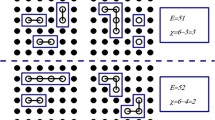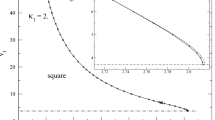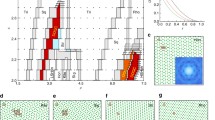Abstract
To the best of our knowledge there is only one example of a lattice system with long-range two-body interactions whose ground states have been determined exactly: the one-dimensional lattice gas with purely repulsive and strictly convex interactions. Its ground-state particle configurations do not depend on any other details of the interactions and are known as the generalized Wigner lattices or the most homogeneous particle configurations. The question of the stability of this beautiful and universal result against certain perturbations of the repulsive and convex interactions is interesting in itself. Additional motivations for studying such perturbations come from surface physics (adsorption on crystal surfaces) and theories of correlated fermion systems (recent results on ground-state particle configurations of the one-dimensional spinless Falicov–Kimball model). As a first step, we studied a one-dimensional lattice gas whose two-body interactions are repulsive and strictly convex only from distance 2 on, while its value at distance 1 can be positive or negative, but close to zero. We showed that such a modification makes the ground-state particle configurations sensitive to the tail of the interactions; if the sum of the strengths of the interactions from the distance 3 on is small with respect to the strength of the interaction at distance 2, then particles form two-particle lattice-connected aggregates that are distributed in the most homogeneous way. Consequently, despite breaking of the convexity property, the ground state exhibits the feature known as the complete devil's staircase.
Similar content being viewed by others
REFERENCES
J. Slawny, Low Temperature Properties of Classical Lattice Systems: Phase Transitions and Phase Diagrams, in Phase Transitions and Critical Phenomena, Vol. 11, C. Domb and J. L. Lebowitz, eds. (Academic Press, London 1987).
M. Bundaru, N. Angelescu, and G. Nenciu, On the ground state of Ising chains with finite range interactions, Phys. Lett. 43A:5 (1973).
J. Miekisz and C. Radin, Third law of thermodynamics, Mod. Phys. Lett. B 1:61 (1987).
S. Aubry, Exact models with a complete devil's staircase, J. Phys. C: Solid State Phys. 16:2497 (1983).
J. Hubbard, Generalized Wigner lattices in one-dimension and some applications to tetracyanoquinodimethane (TCNQ) salts, Phys. Rev. B 7:494 (1978).
V. L. Pokrovsky and G. V. Uimin, On the properties of monolayers of adsorbed atoms, J. Phys. C: Solid State Phys. 11:3535 (1978).
W. J. Ventevogel, Why do crystals exist? Phys. Lett. 64A:463 (1978); On the configuration of a one-dimensional system of interacting particles with minimum potential energy per particle, Physica A 92:343 (1978).
C. Radin, Low temperature and the origin of crystalline symmetry, Int. J. Mod. Phys. B 1:1157 (1987).
J. Hubbard, Generalized Wigner lattices and band motion efects, in Quasi One-Dimensional Conductors II, Lecture Notes in Physics 96, S. Barişić, A. Bjeliş, J. R. Cooper, B. Leontiş, eds. (Springer Verlag, Berlin, Heidelberg, New York, 1979).
M. E. Fisher and A. Szpilka, Domain-wall interactions. I. General features and phase diagrams for spatially modulated phases, Phys. Rev. B 36:644 (1987).
N. Ishimura and T. Yamamoto, Commensurate structures of adatoms on a square lattice, J. Phys. Soc. Japan 58:2439 (1989).
K. Sasaki, Lattice gas model for striped structures of adatom rows on surfaces, Surf. Sci. 318:L1230 (1994).
F. Bagehorn, J. Lorenc, and Cz. Oleksy, A model of linear chain submonolayer structures: application to L t/W(112) and Li/Mo(112), Surf. Sci. 349:165 (1996).
Cz. Oleksy and J. Lorenc, Ground states of a one-dimensional lattice-gas model with an infinite-range nonconvex interaction. A numerical study, Phys. Rev. B 54:5955 (1996).
P. Bak and R. Bruinsma, One-dimensional Ising model and the complete devil's stair-case, Phys. Rev. Lett. 49:249 (1982).
B. N. J. Persson, Ordered structures and phase transitions in adsorbed layers, Surf. Sci. Rep. 15:1 (1992).
M. Marchand, K. Hood, and A. Caillé, Nonconvex interactions and the occurrence of modulated phases, Phys. Rev. Lett. 58:1660 (1987).
K. Sasaki and R. B. Griffiths, Equivalence of certain convex and nonconvex models of spatially modulated structures, J. Stat. Phys. 53:1031 (1988).
J. L. Raimbault and S. Aubry, Non-2kf charge density wave induced by phonon dispersion in one-dimensional Peierls conductors, J. Phys.: Condens. Matter 7:8287 (1995).
L. M. Falicov and J. C. Kimball, Simple model for semiconductor-metal transitions: SmB6, and transition-metal oxides, Phys. Rev. Lett. 22:997 (1969).
U. Brandt and R. Schmidt, Exact results for the distribution of the f-level ground state occupation in the spinless Falicov–Kimball model, Z. Phys. B 67:43 (1987).
T. Kennedy and E. H. Lieb, An itinerant electron model with crystalline or magnetic long range order, Physica A 138:320 (1986).
P. Lemberger, Segregation in the Falicov–Kimball model, J. Phys. A 25:15 (1992).
Ch. Gruber, J. L. Lebowitz, and N. Macris, Ground-state configurations of the one dimensional Falicov–Kimball model, Phys. Rev. B 48:4312 (1993).
C. Gruber, D. Ueltschi, and J. Jdrzejewski, Molecule formation and the Farey tree in the one-dimensional Falicov–Kimball model, J. Stat. Phys. 76:125 (1994).
Z. Gajek, J. Jedrzejewski, and R. Lemański, Canonical phase diagrams of the 1D Falicov–Kimball model at T=0, Physica A 223:175 (1996).
Ya. G. Sinai, Theory of Phase Transitions: Rigorous Results (Pergamon Press, Oxford, 1982).
A. C. D. van Enter, R. Fernandez, and A. D. Sokal, Regularity properties and pathologies of position-space renormalization-group transformations: scope and limitations of Gibbsian theory, J. Stat. Phys. 72:879 (1993).
S. Kakutani, Ergodic theory of shift transformations, Proc. Fifth Berkeley Sympos. Math. Statist. Probability II:405 (1967).
M. Keane, Generalized Morse sequences, Zeit. Wahr. 10:335 (1968).
J. Miekisz and C. Radin, How common are incommensurate solids, University of Texas preprint, unpublished (1987).
J. Miekisz, An ultimate frustration in classical lattice-gas models, J. Stat. Phys. 90:285 (1998).
Author information
Authors and Affiliations
Rights and permissions
About this article
Cite this article
J¸edrzejewski, J., Mi¸ekisz, J. Ground States of Lattice Gases with “Almost” Convex Repulsive Interactions. Journal of Statistical Physics 98, 589–620 (2000). https://doi.org/10.1023/A:1018663106236
Issue Date:
DOI: https://doi.org/10.1023/A:1018663106236




